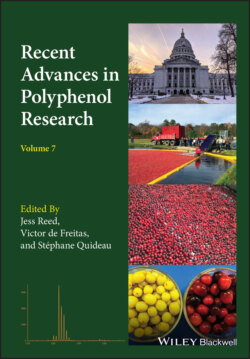Читать книгу Recent Advances in Polyphenol Research - Группа авторов - Страница 34
2.3.4 Approaches via an Acyclic Precursor (Route II)
ОглавлениеWeinges and Theobald (1971) reported a stepwise construction of the dioxabicyclo[3.3.1]nonane skeleton (A‐type) of PAs (Figure 2.11). The Michael addition of the o‐benzyloxyphenylmagnesium bromide to chalcone 12 gave ketone 13. After hydrogenolytic removal of the benzyl protecting groups, the resulting bisphenol was exposed to dehydrating conditions, giving bicycle 14 in 50% yield.
Xia et al. (2014) reported a cascade reaction of 2‐hydroxychalcones with phloroglucinol derivatives by using a catalytic amount of ethylenediammonium diacetate (EDDA, 10 mol%), constructing the dioxabicyclo[3.3.1]nonane skeleton (Figure 2.12). The reaction of 15 with 16 proceeded in refluxing toluene via the Michael reaction followed by an internal acetal formation, giving the condensation product 17 in 87% yield.
Kraus and Geraskin (2017) reported a facile one‐pot formation of the A‐type structure (Figure 2.13). Under acidic conditions, twofold nucleophilic reactions of phloroglucinol to acetylenic aldehyde 18 generated bis‐arylated 19 as an intermediate, which underwent acid‐catalyzed acetal formation to give bicycle 20. After acetylation, tetraacetate 21 was obtained in high yield.
Figure 2.9 Oxidative conversion of the B‐type to the A‐type structure.
Figure 2.10 Radical‐mediated oxidative conversion.
Figure 2.11 Stepwise construction of the A‐type structure.
Figure 2.12 Cascade reaction of 2‐hydroxychalcones with a phloroglucinol derivative
Figure 2.13 One‐pot formation of the A‐type structure.
